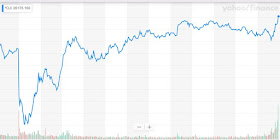The Institute for Supply Management’s said its non-manufacturing index fell to 52.6 last month from 56.4 in August. Economists polled by Marketwatch had forecast a 55.3% reading.That’s the lowest level in ISM’s non-manufacturing index since 2016, and it showcased a decline in growth for both output and jobs.
Numbers over 50% indicates business conditions are getting better, but the index has fallen 8 points below its postrecession peak of 60.8% achieved last fall.
Business production and new orders grew more slowly in September and employment levels were basically flat.That near-flat employment gauge combined with a disappointing reading on payrolls from ADP yesterday makes tomorrow’s US jobs report a big one. If that one shows even lower growth from the already-declining amounts that we’ve seen in recent months, the slide may be nearing the point of no return.
The index for production slid to 55.2% from 61.5%.
The employment gauge dropped to a five-year low of 50.4% — barely above the cutoff point that separates net hiring from net layoffs.
In addition, we received more proof of manufacturing’s struggles, as the US Census Bureau reported more areas of weakness.
New orders for manufactured goods in August, down following two consecutive monthly increases, decreased $0.4 billion or 0.1 percent to $499.8 billion, the U.S. Census Bureau reported today. This followed a 1.4 percent July increase. Shipments, down two consecutive months, decreased $0.7 billion or 0.1 percent to $503.0 billion. This followed a 0.3 percent July decrease. Unfilled orders, up two consecutive months, increased $1.1 billion or 0.1 percent to $1,162.9 billion. This followed a 0.1 percent July increase. The unfilled orders‐to shipments ratio was 6.66, down from 6.67 in July. Inventories, down following eight consecutive monthly increases, decreased $0.3 billion or virtually unchanged to $695.9 billion. This followed a 0.1 percent July increase. The inventories‐to-shipments ratio was 1.38, unchanged from July.So new orders down, shipments down, with inventories up 3% compared to last year, even with the slight decline in August.
It was especially bad in the auto sector in August.
August 2019 manufacturing report
Motor vehicle bodies, parts and trailers
New orders -0.1% Aug 2019, -0.5% year-over-year
Unfilled orders -0.5% Aug 2019, -0.8% year-over-year
Inventories
Automobiles +0.5% Aug 2019, +21.7% year-over-year
Light trucks/utility vehicles +2.5% Aug 2019, +6.7% year-over-year
And this slowdown in orders and piling up of inventories was a month before the GM strike started. Those are awful signs going forward.
When the ISM Services and New Orders reports dropped around 9 Central time, the stock market panicked, with the DOW dropping by more than 300 points in less than 10 minutes, making for a total loss of well over 1,100 since Monday. But then it recovered and finished up 122 for the day (with most of that net gain suspiciously coming at the end of the trading day).
What happened?
1. I'm betting computers and charts played a role, as major buying came in once the DOW and NASDAQ hit their 200-day moving averages. I suppose this is a good sign, in the sense that there was a support level, but there’s no legitimate economic growth driving that trading behavior.
2. The economy is doing so bad that it increases the chances of MOAR COCAINE from the Fed.
U.S. stocks recovered from early losses to trade mixed Thursday, after a report showed the U.S. services sector growing at a slower pace than at any point since 2016, prompting traders to price in another Federal Reserve interest rate cut at its late October meeting…But allowing for cheaper gambling on Wall Street isn’t a cure for what ails the real economy. And with the jobs report looming, we might see tomorrow just how far around the bend this economy might be.
“Net, net, look out below is what purchasing managers from services industries are shouting at the markets as the fears of recession continue to mount,” MUFG chief economist, Chris Rupkey wrote in a note. “This downturn is starting to spread and that means the tea leaf readers at the Fed are going to be teeing up a third rate cut this year when they next meet again at the end of this month.”
However, the chances of another interest rate cut by the Federal Reserve increased following the release of weak data on the services sector. Expectations for an October rate cut jumped to 93.5% from 77% on Wednesday.


No comments:
Post a Comment